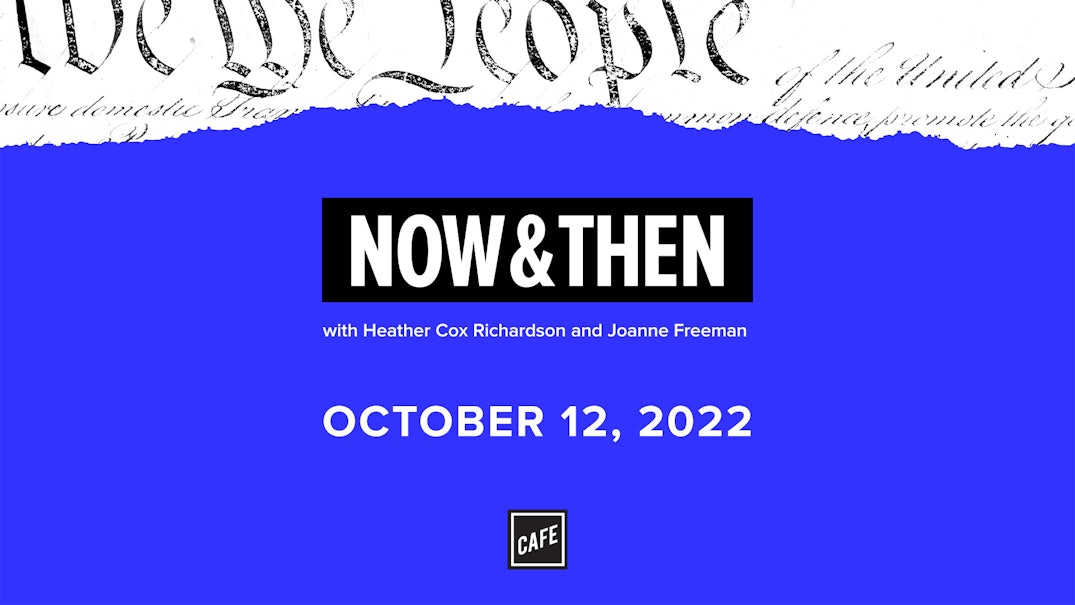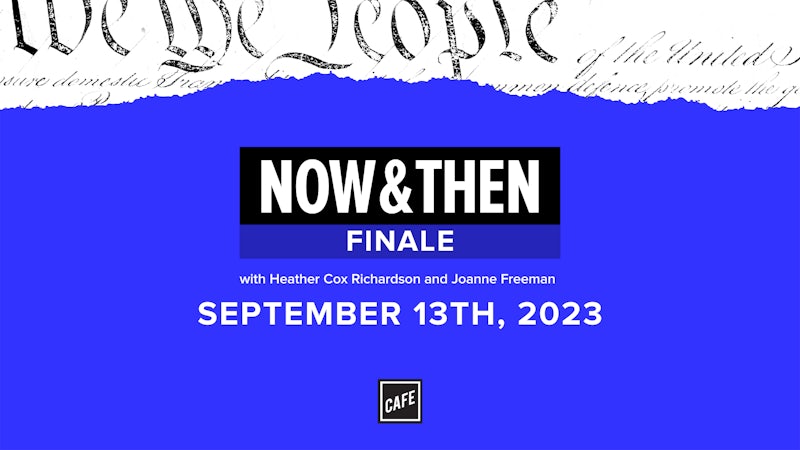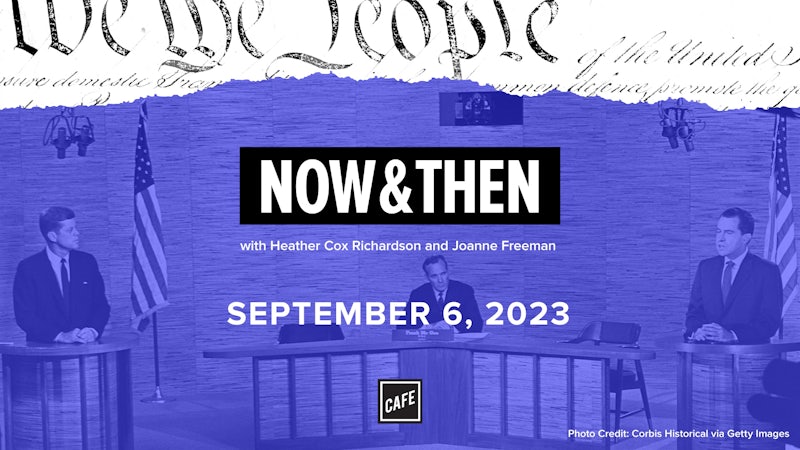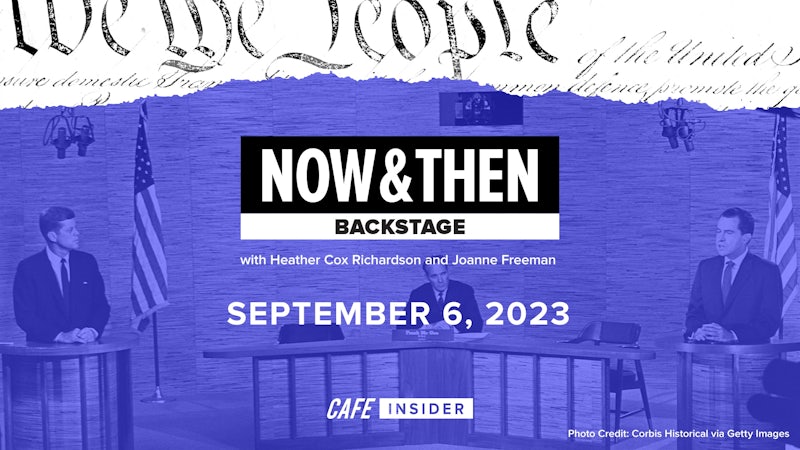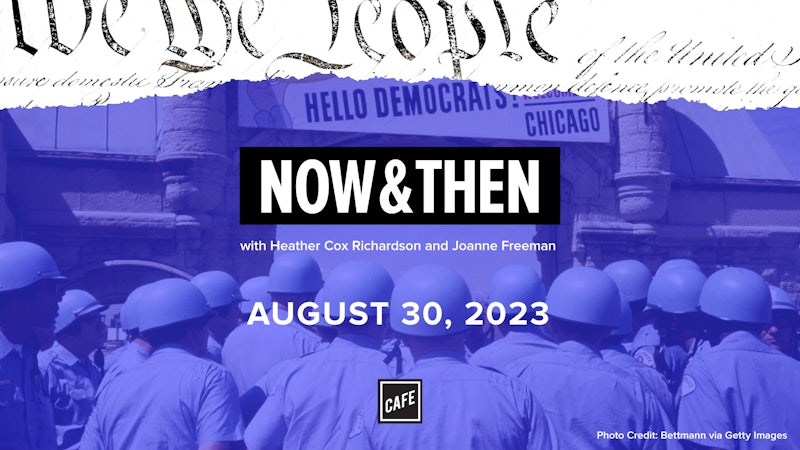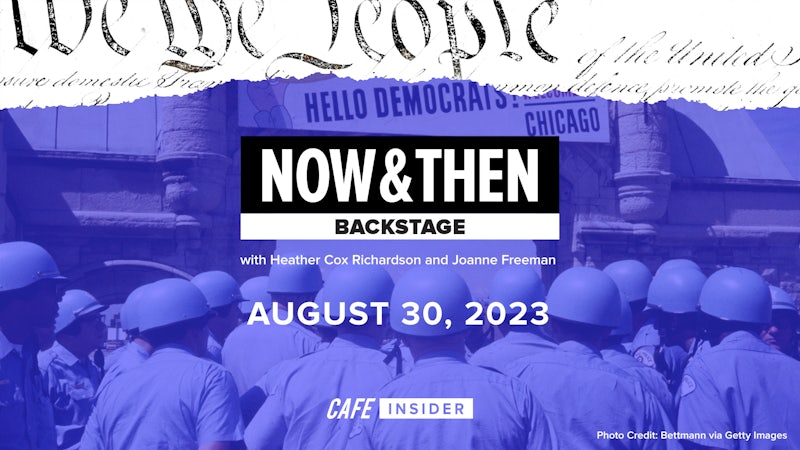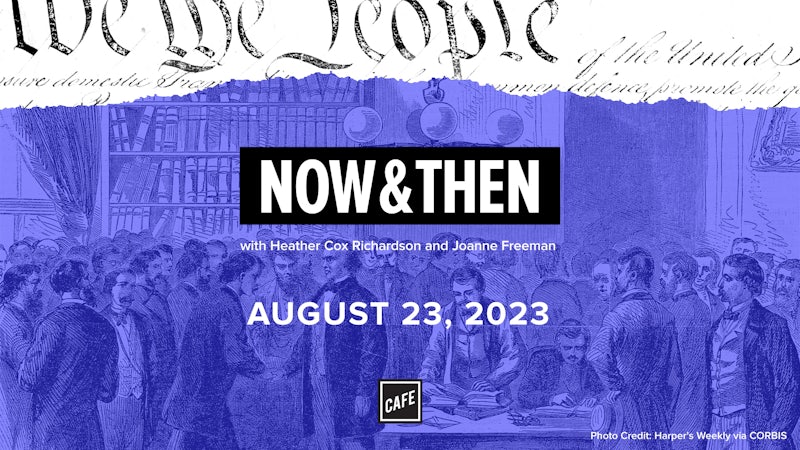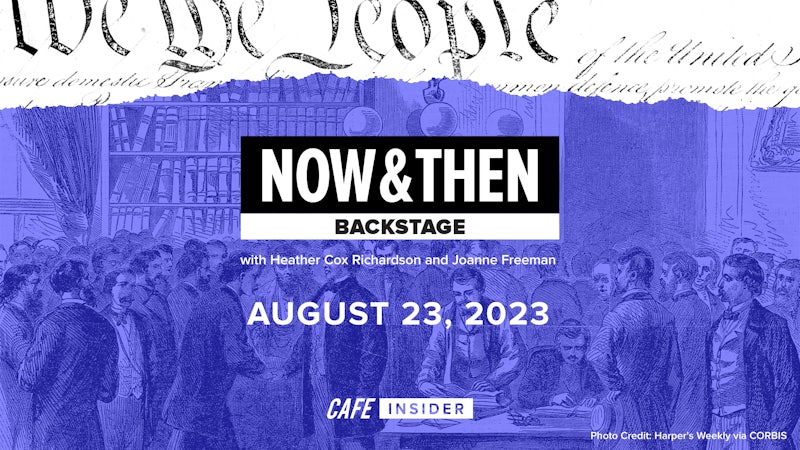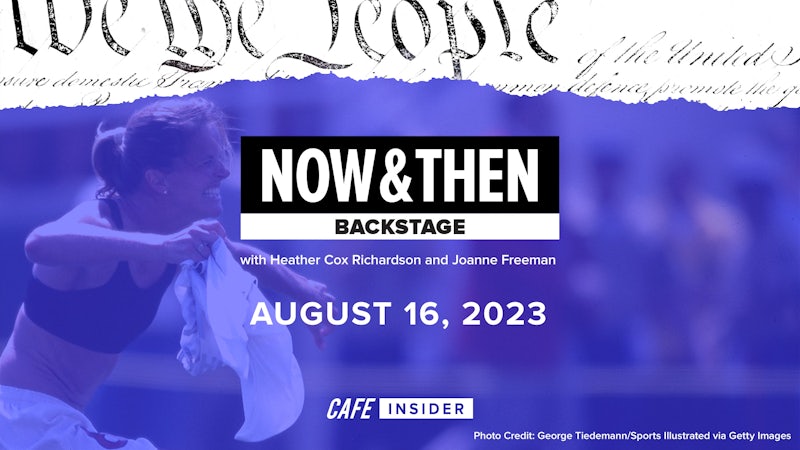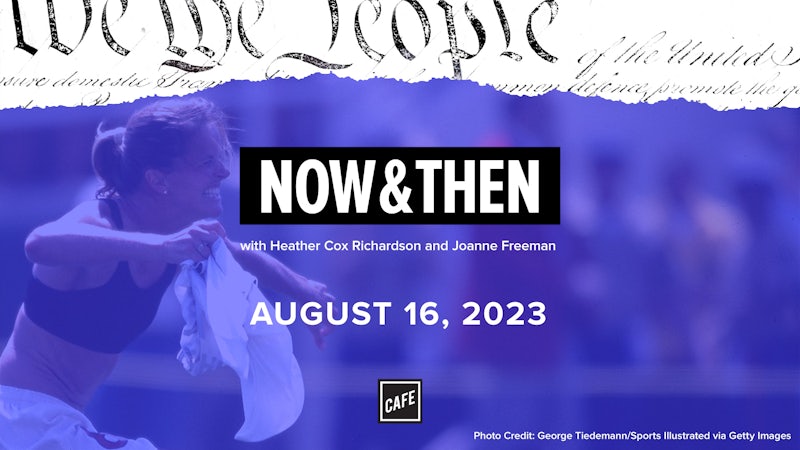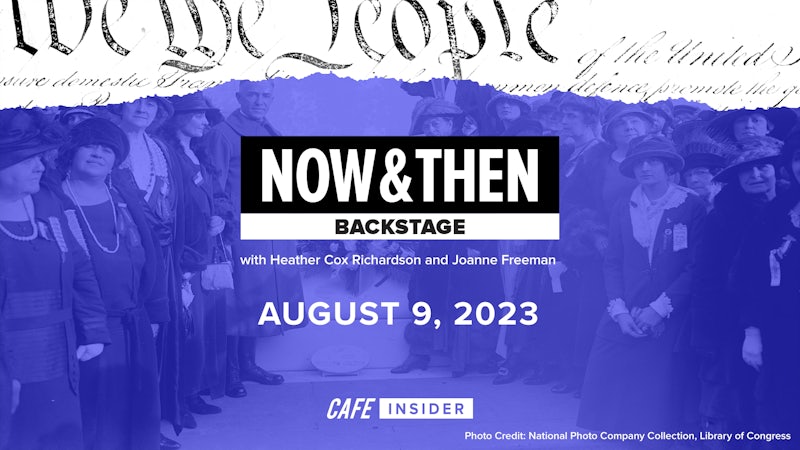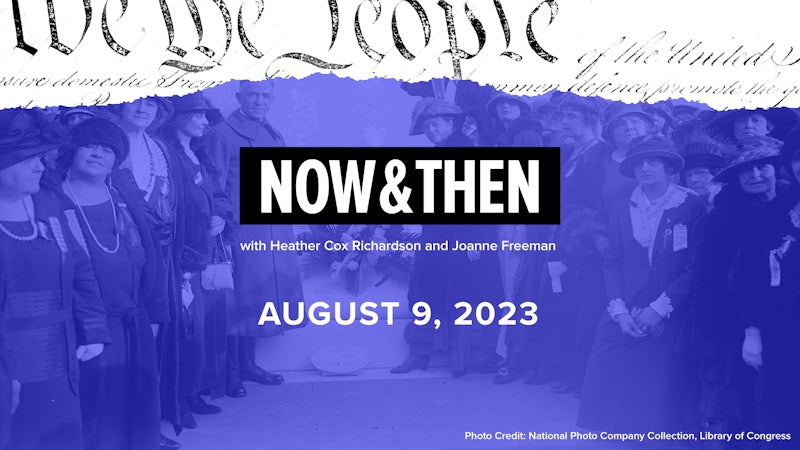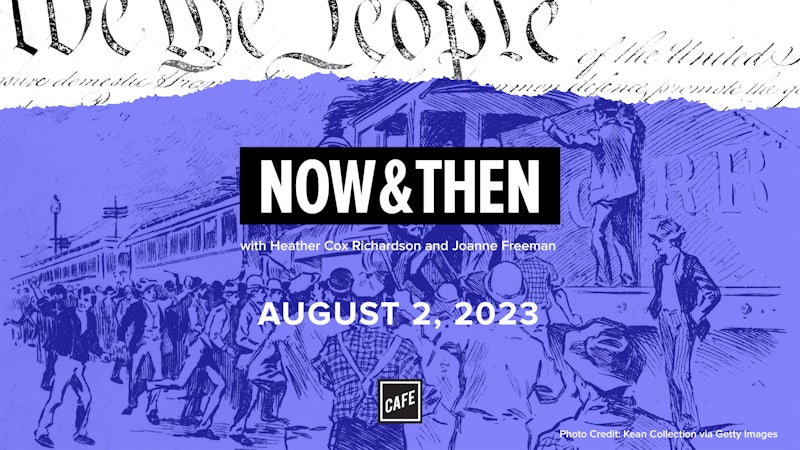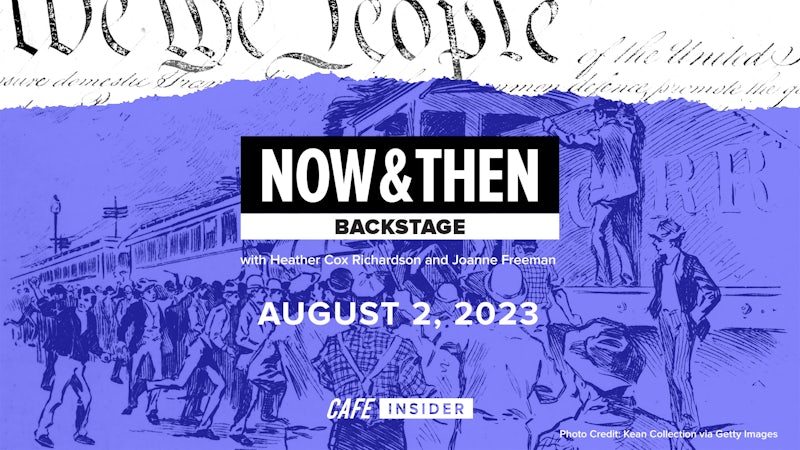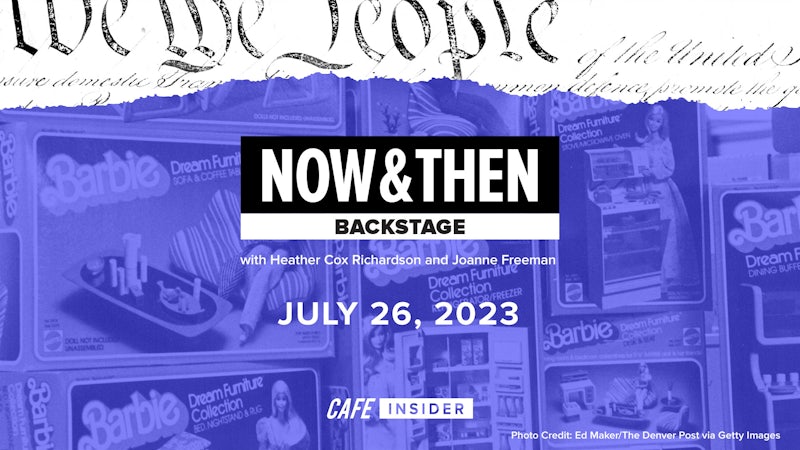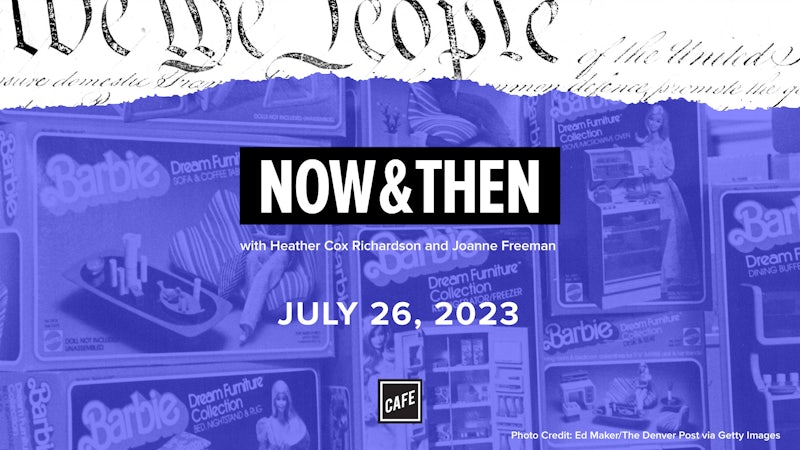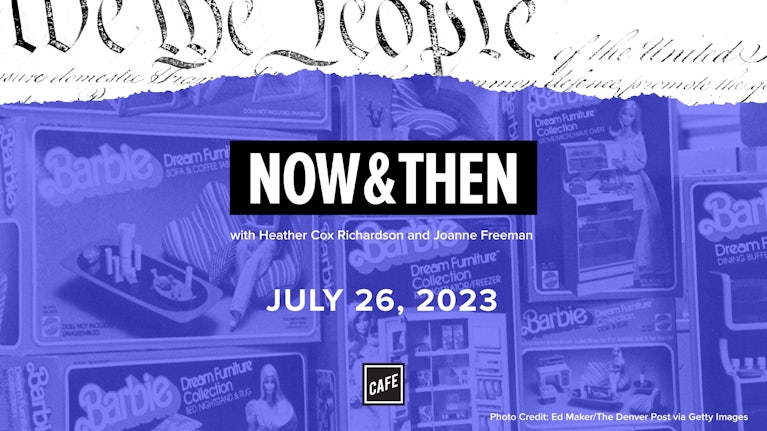Heather Cox Richardson:
From CAFE and the Vox Media Podcast Network, this is Now & Then. I’m Heather Cox Richardson.
Joanne Freeman:
And I’m Joanne Freeman. Today, we’re going to be talking about a topic that came to us as a result of something that burst out, partly on social media, on September 28th, and that was the response to the pop and hip hop superstar, Lizzo, playing a crystal flute that belonged to James Madison on stage during her performance. Those of you who have seen the footage, she was clearly very excited by it. She held it above her head after playing a few notes and she said something that Heather makes hearing and my heart proud.
Lizzo (archival):
We just made history tonight. Thank you to the Library of Congress for preserving our history, and making history’s freaking cool.
Joanne Freeman:
So she emphasized the meaning of her having James Madison’s Crystal Flute not really heard before, playing it before an audience. And, apparently, she had been invited to the Library of Congress by Librarian of Congress, Carla Hayden. She said that the Library of Congress has the largest flute collection in the world with more than 1,800 flutes, including James Madison’s 1813 crystal flute. “Lizzo, we would love for you to come see it and even play a couple when you are in DC next week,” for her performance. And Lizzo basically wrote back, “I’m coming and I’m playing that crystal flute.”
So those of you who have been seeing some of this online, there’s footage of her at the Library of Congress playing a variety of these different flutes, and then she does indeed take Madison’s 1813 flute and played that on stage during a performance, which prompted a really big outcry of angst by some who were outraged on the right at the fact that she had played this flute, which, of course, no one had known really existed before she played it. But it was shocking and it was horrible. Some people even claimed the only reason she did it was to be provocative and offensive.
Heather Cox Richardson:
I was going to ask you, Joanne, did you know that flute existed?
Joanne Freeman:
I did not. I know a lot of trivia about Founder Folk and no idea about that at all. And, as a matter of fact, my first response to hearing this was, “Oh, how interesting. It’s an instrument from James Madison. There’s so much amazing stuff in the Library of Congress, and I worked there, was employed there, and I had no idea that this was there.”
Heather Cox Richardson:
Well, my first reaction was that she plays brilliantly, and I will confess this, we’re going to confess a lot in this episode, that I did not know who this woman was, and I heard her play it, and I was like, “Whoa.” So I actually went and listened to all the other tapes that they made of her playing the different instruments that were available to her that day in the Library of Congress. And I was, first of all, totally astonished that anybody could take instruments, not just flutes. There were some other ones she played as well, and just pick them up and play them that well when they are, in fact, differently fingered than anything a modern day performer would use. I was also though interested that when people began to attack her for that, to my mind, it was like, “Oh, this is so wonderful because you’re bringing to a whole new generation, really a whole new world, this artifact from the past. And, yes, it shows that history is cool, but it also, to me, said something more profound than that, in that it really illustrated that music is universal.” That this is a flute that apparently James Madison didn’t even know how to play it. It was a gift to him, and the guy who made it actually was mad that Madison never thanked him for it.
But then it gets handed down to a relative who basically it probably had to be sold for gambling debts and all these years later, this woman who was trained as a classical flautist, but who has created a career in a different field, was able to pick that up and make it speak again. I just thought … I could not stop watching it because it was just like, “Oh, wait, there’s an artifact from freaking James Madison who is not, for most of us, part of our daily lives, and this woman in the 21st century is playing it.” And you know what I kept thinking? There were lots of people complaining about the artist herself, the way she looks, her body positive message, all those things, which I just thought missed the whole point. But I had to laugh because I was thinking, “What would James Madison say about this?”
Joanne Freeman:
Part of the reason why there was that enormous response was because of all of the racial components bound up with this and, in part, it was an instrument owned by a slave holder that now is being played by a black woman in front of a huge audience who’s very successful. It felt to me that if you were going to create a moment that was going to rev up people’s engines in 2022, on all sides, for better and worse, this was an example of that. I will say this makes me feel sadly hip for an old white person. I did know who Lizzo was and I actually like her music, and I’ve seen her pull out a flute during her performances, right? So that’s actually a part of her popular music persona. I haven’t answered your question actually, which is what would Jay Madison?
Heather Cox Richardson:
Well, I have to say he was not just an enslaver, he’s also one of the key architects of the Constitution that tried to establish a system of white supremacy going forward. It was even in a way more significant than if he had just been James Henry Hammond, who was just a pig. He was the architect of the system.
Joanne Freeman:
The easy response to that would be to say that he would be offended because she’s doing this before a huge public and she’s using something of his without his permission and she’s getting applauded for it. You could also say there’s a long tradition of white people sitting back and enjoying black people playing music and taking that as a kind of fake submissiveness instilled in that by some of the white audiences looking on. So it’s hard to know I think what Madison would think. I think the easy answer is that he would be offended that there’s not only a black person playing his flute, but a black woman. But I think the answer might be actually more interesting and more complicated.
Heather Cox Richardson:
Well, I got one for you. I could not get away from the fact that if James Madison were watching that, he would be so completely blown away by the lights, which think of his era, they didn’t have lights like that and the flashing, and that he probably never would have gotten to being able to get the whole rest of it there. He’d have been like, “Oh my God, look at the lights,” which I’m not really just making fun in the sense that it really does illustrate what a different era we live in now than we did back then.
Joanne Freeman:
As someone who works on early America, you’re constantly asked, “What would so and so,” fill in a founder name, “think of X current thing?” And very often my response is, he would say, “What are those metal boxes in the sky? How is this box in your room talking?” Like they’re going to be totally blown away and shocked and terrified about the world around them, which, as you’re saying, major point here in history generally, but particularly in the founding period, it’s so far removed that at the same time that we can look back to that period and look for the roots of some of the things that we have now. That’s a really different period of time. And, thus, the glory and power of Lizzo playing James Madison’s flute on a stage in 2022.
Heather Cox Richardson:
It really does highlight just how different the world of the framers was. But that’s not we’re here to talk about today. We’re here to talk about a really cool topic today, which is the use of instruments in new ways in society. There’s a so much to say about this. So the obvious place to start, of course, is with the banjo. The banjo comes from two precursors from West Africa and enslaved black Americans brought those ideas about those instruments to North America and recreated similar instruments, not exactly the same, but similar instruments in the American South. So what we eventually ended up with, and it takes a while for it to develop, is a five-stringed instrument that has a neck and has a covered resonator that was originally in its precursor, a gourd, and it’s tuned to an open G chord. It’s almost always finger-picked, and if you think about the difference between it and a guitar, a guitar has six strings of different tuning, quite a different tuning actually, and can be strummed as well as finger-picked and a banjo can as well, but they’re usually, the real difference is banjos now almost always finger picked.
Joanne Freeman:
And, interestingly, actually, since you mentioned just a moment ago the similarity and differences between the banjo and the guitar, Thomas Jefferson makes that link when he talks about what he calls the Banjar, B-A-N-J-A-R, in notes on the State of Virginia in the midst of a passage that probably many people know in which he’s basically really attacking black biology, black anatomy, and everything else. But what he says in the middle of that passage is, “The instrument proper to them is the banjar, which they brought hither from Africa, and which is the original of the guitar, its chords being precisely the four lower chords of the guitar.” So that’s how he sort of placed, again, looking at this as a sort of originator or something that came along later.
Heather Cox Richardson:
So let’s start with the actual construction of a banjo, because this is going to be important in all the instruments we talk about, and that is they are constructed with tools one has to hand that enable people who don’t have access to harpsichords, for example, or some of the other stringed instruments coming out of Europe because they’re either not accessible or they’re too expensive. The reason I love these instruments is because they’re really expressions of that impulse for music I was talking about before, but from people who don’t have access to money or perhaps to the kind of lessons one might need, for example, to work on a harp, and those are going to be significant in the way that these instruments get adopted into our culture. So the banjo can be made by a number of things. There’s a man who been a Confederate surgeon in the Civil War explained how he had learned to play a homemade banjo that had been owned by one of the enslaved people on an Alabama plantation in the 1850s.
So John Allan Wyeth wrote an autobiography in 1914 in which he said, “I learned to play upon a banjo, which one of our slaves, who was a very good performer,” okay, hang on to that, “helped me to make when I was about 11 years old. The rim was made from the circle of a cheese box.” Okay, so a cheese box or something like it is something that would be in many homes. “A calfskin soaked in lime solution, which removed the hair, was tacked while wet over one surface of this while the stem was carved from a suitable piece of soft poplar. I was extravagant enough to import four catgut strings and a wire bass, which excited no little curiosity, as they were the first ever seen by …” the people around him. “To the uninitiated, there would probably be some surprise at the quality of the music or harmony, even if crude, which could be produced by playing on this primitive instrument.” So you’ve got this thing that could be constructed by people who were basically using what they had to hand in the woods and what came into their neighborhoods, if not their homes, in packing materials.
Joanne Freeman:
So you have people creating instruments to make music, to give voice to what they’re feeling and thinking based on what they have at hand. You have, as this Confederate surgeon just demonstrated, white people, actually like Jefferson too, white people seeing this instrument and seeing it being played and being intrigued with it. And then in the early 1830s, you have Joel Walker Sweeney, a blackface minstrel performer from Virginia who begins to experiment with banjos in his shows.
So now we have a white performer performing in blackface, who is taking the banjo, performing before an audience. He’s credited with popularizing a fifth string on the banjo, but really more significantly, bringing the banjo to a large scale white audience. As with Wyeth, Sweeney learned to play the banjo from black Americans who were enslaved by his family and he traveled around playing the banjo and made an enormous impression. People responded enormously to this new instrument. He was playing often black spirituals on a instrument created by African-Americans and being watched by white people and in blackface, and it was the white audience that was seizing upon this and grabbing at it as something new and wonderful and really popularizing Sweeney for being the guy who’s introducing them to the banjo, what it sounds like and what it is. He even ultimately tours England, Scotland, and Ireland performing a command performance for a young Queen Victoria in 1843. So he gets credit really for the banjo, not just for popularizing it, but in a sense, for the banjo itself. Not a new story.
Heather Cox Richardson:
So we literally have enslaved people creating instruments from whatever they have to hand and playing on them incredibly well, and a white performer takes them and popularizes them and associates them with the American South and this nostalgic old south plantation home concept in, obviously, all kinds of co-option there. But one of the things that I think really jumped out to us is a song that probably everybody knows, written by a minstrel composer before the Civil War, Stephen Foster, a name, again, many people know, in 1848 wrote the famous song, Oh! Susanna. This is portrayed by a man who made his fortune as the person who wrote the minstrel songs, but he is representing in this song an African-American who has left the South and is longing to go back.
Joanne Freeman:
Heather and I and the producers were talking about this beforehand because, like you, we know this song and I was saying like, “Oh, yeah, banjo on my knee, I hadn’t thought about that before.” But all of us did not have the context of its link with slavery. Once we thought about it, we thought, “Oh, yeah, it probably is a song about someone wanting to go back to the south,” but in the way that, I mean, we sang it in grade school, stripped of all of its meaning and just as kind of an American folk tune. So, even now, you can see these instruments and their music being adapted and claimed and portrayed as something that they really didn’t start out being.
Heather Cox Richardson:
So the banjo becomes associated increasingly with the minstrel performers rather than the enslaved African Americans who both adapt the old African instrument to the United States and then who actually really begin the playing of it. By the end of the 19th century, white people, even white women, were taking banjo classes. They were learning to play the Banjos. One newspaper in 1888 said, “All the maidens and a good many of the women also strum the instrument. Banjo classes abound on every side and banjo recitals are among the newest diversions of fashion. Youths and elderly men, too, have caught the fever. The star strummers among men are in demand at the smartest parties and have the choosing of the society of the most charming girls.”
By the early 1920s, the banjo is becoming part of the emerging style of what is going to become country music in the 20th century. And, in 1925, Uncle Dave Macon began to appear on the radio from the Grand Ole Opry in Nashville, Tennessee. He had been a banjo player since the 1880s. He could play in a number of different styles, and that’s going to spark in the Opry a banjo renaissance. That then begins to focus the banjo on the country music that’s developing in places like Appalachia.
Joanne Freeman:
It segues to country music. As it kind of fades a little bit from country music, it moves into the southern mountains and becomes part of what people might call Mountain Music Appalachia. And then you get Alan Lomax, the famous ethnomusicologist, so well-known for collecting different kinds of music, a lot of folk music, a lot of Appalachian music and, actually, his collection of recordings is at the Library of Congress. He then is going and collecting, it has migrated banjo music into the mountains. He collects it. There are now new songs and new histories. The banjo is now migrating again, transforming again into something else.
Heather Cox Richardson:
That transition ended up giving rise to Earl Scruggs, and Earl Scruggs introduces the instrument into what is now known as the bluegrass style in the late 1940s. Everybody probably has heard of his 1949 instrumental Foggy Mountain Breakdown, which is sort of still everywhere and a classic. And, of course, it’s no accident that with this long history of the banjo leading up to bluegrass music, that Joanne and I chose to put bluegrass sounds in the intro to this show.
Joanne Freeman:
That’s true. I had forgotten about that.
Heather Cox Richardson:
Yeah.
Joanne Freeman:
That’s very true. And the last little point we have to throw in here, only because it’s the final sort of irony, I guess, it’s a transition, is that Earl Scruggs song, Foggy Mountain Breakdown, it’s featured in the 1967 film, Bonnie and Clyde, and hits number 55 on the Billboard Hot 100 Chart. So there we go.
But what’s interesting to me about all of this, this transformation, Heather, that you and I just described, there’s a book written in 1983 called Ring the Banjar: The Banjo in American Life from Folklore to the Factory by historian Robert Lloyd Webb, and I just want to read a couple sentences in it because, to me, it captures so much about what we’re talking about in transitions of meaning and music, because that’s a remarkable transition that we just outlined with the banjo.
Webb says, “The history of the banjo in America tells something of the history of the nation. The banjo takes a place in our folkways, in our humor, and in the tragedies of our past. The banjo belongs to all of us: to blacks, to whites, to the first immigrants and, by adoption, to many of the latest. It casts both bright and dark shadows: Banjo is frolic, but banjo is slavery. Banjo is entertainment, but banjo is blackface. Banjo accompanies the dance, but dancing in bondage, longing to be free.
Heather Cox Richardson:
So next, we wanted to take on another fascinating instrument, and that’s the steel drum, which is also known as a steel pan, and, like the banjo, it is a musical instrument that is made from repurposed other objects, and it is a repurposed oil drum in which one end has been beaten down and has been divided by grooves into sections that give the 12 notes of the chromatic scale on a single pan. So steel pan is a beaten oil drum. The steel pan emerged from Trinidad, and Trinidad, of course, is colonized by Christopher Columbus on his third voyage in 1498, and it was controlled by Spain until 1802, when Britain then took control of the island. And that’s going to matter in a minute because African slavery was abolished in Trinidad as well as in the rest of the British empire in 1834. So shortly after their emancipation, black Trinidadians began to hold a yearly harvest festival that is later going to become known as Carnival. And after a series of riots in the 1880s, the British, and I love this, our producer wrote, outlawed percussion.
Joanne Freeman:
I know and, in the margin, Heather, says, “What does that mean?”
Heather Cox Richardson:
What does it mean to outlaw percussion?
Joanne Freeman:
How do you outlaw percussion?
Heather Cox Richardson:
And the answer is the British band, the kind of African hand drum that had been played at the festival, because that they said that it incited riots. And the British colonizers passed a law that prohibited, and I love this, singing, dancing, drumming, and other music-making by rogues and vagabonds, which obviously is not laughable to the people at the time because they, of course, would decide who was a rogue and who was a vagabond.
Joanne Freeman:
I was going to say, actually –
Heather Cox Richardson:
And I promise you, it was exactly you think it was. Anyway, they imposed a ban on all drumming. They refused to allow drums in street parades. They refused to allow the blowing of any horn or the use of any other noisy instrument. They also prohibited anybody carrying torches, dancing, processing together or assembling in groups of more than 10 persons with sticks or other weapons of offense. So the Trinidadian said, “Okay, that’s fine. We’re never going to make music again.”
Joanne Freeman:
Yeah, not so much. So this is the continuing theme. The Trinidadians began finding substitutes for drums. They just found another way to voice what they wanted to voice. And, initially, they used bamboo as a kind of substitute. But then in the 1930s, a small group begins to experiment with creating different tonalities using car parts, and paint pots, and dust bins, and oil drums, and biscuit tins. So, again, this theme here that people are taking what’s around them and, in this case, they’ve been told they’re not allowed to use drums, so they see what’s around them and they create instruments so that they can make the kind of music that they want to make and that they can get around whatever laws have been made to express what they want to express. And, in the end, oil drums were particularly popular.
Heather Cox Richardson:
When we’re on the idea of innovation and the creation of new sounds. One of the things that always jumps out at me is human creativity. Like, I could no more look at an oil drum and say, “Oh, I can turn that into a fine instrument, then I could fly.” And they took oil drums and they turned them into musical instruments.
So, in 1941, Britain permits the US Navy to establish bases on Trinidad and US soldiers start to love the Trinidadian Calypso music and the steel pan subculture that is coming from it. Trinidadians, for their part though, have extremely mixed feelings about US presence on the island. So while all that’s going on, there’s a Calypso singer named Lord Invader, who writes a song of resentment against this occupation by the Americans called Rum and Coca-Cola. And the song talks about how soldiers are corrupting Trinidadian women with promises of wealth. So the song goes, “And when the Yankees first went to Trinidad, some of the young girls were more than glad. They said that the Yankees treat them nice and they give them a better price. They buy rum and Coca-Cola, went down Point Cumana. Both mothers and daughters working for their Yankee dollars.”
Joanne Freeman:
This is another one of those moments that, in a sense, is the underlying theme of much of what we’re saying today. So in a very strange transition moment, actor Morey Amsterdam … he was in the Dick Van Dyke show, right? Actor Morey Amsterdam heard Lord Invader sing the track during a North American tour and, here’s the unsurprising part, copyrighted the lyrics and gave them to The Andrews Sisters to cover. And The Andrews Sisters’ version went on to be number one on the billboard singles chart for 10 weeks.
Lord Invader sued for copyright infringement and received a $150,000 settlement in 1948. Amsterdam kept the copyright. That is like this weirdly dramatic extreme version of what we’re talking about here over and over again. This American actor likes this, hears it, copyrights the lyrics, gives it to The Andrews Sisters, and then ends up making a number one hit. The taking of these forms of music that are coming from people who are trying with amazing creativity to express themselves in music, and we have these variety of white wanderers coming across these instruments, recognizing them for what they are and, in one way or another, capitalizing on them.
Heather Cox Richardson:
The embrace in America of that Trinidadian Calypso, combined with the fact that a number of Trinidadians began leaving the island for the United States after World War II, a pioneer of steel pan, Rudolph King, came to New York City from Trinidad in 1949. He formed a group called the Trinidad Steelband, which toured the southwest Texas, Oklahoma, came over to the Carolinas, and went up to Canada. And he later reflected on both the segregation of the early tours and the way music bridged that in some ways. He said, “Everything was in black and white. The toilet doors were painted black for black people and white for whites. Then you couldn’t eat because they weren’t serving you with the signs marked, “No,” the N-word, “allowed. All these things. It was a hell of a experience. Still, when you played at places, the people used to appreciate the group. But that’s all you did. You played and then got out of there.”
Joanne Freeman:
And, in this case, Pete Seeger makes an appearance, and I really like Pete Seeger. I grew up with his folk music. My parents played Weavers music all the time. So you get to the late 1940s, there’s a young steel drum player named Kim Loy Wong, and folk singer Pete Seeger becomes entranced by steel pan, sees Wong’s group known as the Highlanders, during a 1956 trip to Port of Spain, Trinidad, and he asks Wong how the drums were made. So Wong brings Seeger to his backyard and Seeger films him building a drum. And, ultimately, Seeger stuck around. He filmed and edited a 16-minute documentary called Music from Oil Drums about Wong’s journey with the drums and, three years later, in 1959, Seeger orchestrated a Folkways album, The Steel Drums of Kim Loy Wong. And when I was thinking about this in preparation for the episode, I thought, “Hey, Wong is getting credit for what he did.” This is very exciting, right? And it does help to bring steel pan to a far larger audience in the United States.
So Seeger, who, he’s an activist. Obviously, he’s on the left, he had been blacklisted for his alleged Communist affiliations, oddly enough, ends up collaborating with a conservative US Navy rear admiral named Dan Gallery, who founded the US Navy Steel Band in 1957, after attending Carnival in Trinidad. Gallery ordered steel pan drums from a pioneer in the playing of steel pan drums, and basically said about developing a Navy band to help with recruitment. And Seeger and Gallery corresponded as the Navy Steel Band grew, with Seeger providing advice on drum-building and kinds of playing and commercial ventures. When Gallery wrote Seeger about a potential appearance on the popular TV variety show hosted by Arthur Godfrey, Seeger was very enthusiastic. “If your Steel Band can get on Arthur Godfrey’s show, that is exactly what is needed to give the whole thing a great kickoff. There will be thousands of people in America begging to know where they can buy them and begging to know how to make them. I agree with you 100% that the instrument is liable to spread around the world. It is unbeatable on parade.”
Heather Cox Richardson:
So the Steel Band music starts again to spread around America until they start to accept corporate sponsorship.
Joanne Freeman:
Wah, wah.
Heather Cox Richardson:
Well, but I’m sorry, it makes total sense where they get corporate sponsorship, they are sponsored.
Joanne Freeman:
Just think about it. Before you say it, give the audience a second or two to think, “Huh? Who would be interested in promoting steel drums?”
Heather Cox Richardson:
Made from?
Joanne Freeman:
Oil cans.
Heather Cox Richardson:
Steel can groups become sponsored by oil companies because they recognize that there is a tie end to their drums. For example, in 1967, there was a band called the Triple E Steel Orchestra that was backed by, at the time, Esso became Exxon, of course. It caught the attention of Liberace, the entertainer in Montreal at the Expo World’s Fair, and they went on a two year tour with that pianist. Just like the banjo, steel pan becomes increasingly popular until finally, in 1977, it breaks into pop music when Jimmy Buffett adopts it for his Changes in Latitude, Changes in Attitude album and his song Margaritaville, which is sort of a laid-back nibbling on sponge cake, watching the sun bake, all of those tourists covered with oil-
Joanne Freeman:
Wastin’ away again in Margaritaville.
Heather Cox Richardson:
That goes up to number eight on the Billboard Hot 100 and creates an American cultural fascination with the Caribbean, including, of course, Buffett-backed restaurants called Margaritaville, and the people who begin to follow Buffett around to his concerts are known as parrotheads, and he becomes associated with the steel pan, which brings the rhythmic background to a lot of his music. So, in many ways, the steel pan follows the course of the banjo, and that brings us to the third instrument we wanted to talk about, which, to my mind, is really in a way the most fun because I knew the least about it.
Joanne Freeman:
This instrument is obviously bound up and defines a huge genre of music. The term that comes to define the instrument, although in my researching around over this, there’s a lot of conflicting claims about who claims to create it. But the turntable, turntabling is what it ends up being called, which is a major aspect of hip hop and rap. Think about DJs, think back to the age of disco and after, and you have MCs, DJs up on stage playing with the turntables, moving them back and forth, changing, shifting things back and forth in music, skipping, scratching,
Heather Cox Richardson:
And I love this because, according to music critic, Alex Ross, the movement to use turntables in these new ways comes, as he says, up from desperately impoverished, high rise ghettos where families couldn’t afford to buy instruments for their kids, and even the most rudimentary music-making seemed out of reach. But music was made all the same. The phonograph itself became an instrument.
Joanne Freeman:
I’ll add to that, too, that part of that rise of this kind of music is also tied to people coming from Jamaica in the 1950s and 1960s, and until 1995, Jamaica apparently had limited music copyright laws, which meant that reggae DJs could use records for their own creative ends, and they used sound effects and vocals, and they played with rewinding records. So they were already creating their own musical compositions using records, and they brought that with them when they came to the United States. So that’s another thing, feeding into this new kind of music.
Heather Cox Richardson:
And it really starts to emerge in the United States in the 1970s, where DJs like Kool Herc, Africa Bambaataa, and Grandmster Flash, used turntables to create this really collage of effects, loops and breaks and beats and scratches, and create a whole different world out of music. And maybe it’s worth actually expressing here the difference between hiphop and rap, which is highly contested. I mean, it is worth pointing out, of course, that we’re two old white ladies talking about this as a cultural and historical phenomenon and our younger producers are being very helpful.
Joanne Freeman:
They are, and they’re being very sweet, and we are very excited and in the middle of all this, and we are not the most knowledgeable human beings on this. But we are very excited to discuss it and learn about it.
Heather Cox Richardson:
But in a way, that’s a good thing.
Joanne Freeman:
Yes.
Heather Cox Richardson:
I always think of this as being the intelligent Martian.
Joanne Freeman:
Yes.
Heather Cox Richardson:
Because I was like, “Okay, MC, what does MC stand for?” And the answer is that MC stands for a master of ceremonies. So hip hop is a musical style that has a number of elements to it. Generally, again, highly contested, it describes a cultural world, really not simply music, but a master of ceremony is usually wrapped rhyming lyrics. A DJ created a beat and oversaw the turntable and/or boomboxes where they would create effects in real time. So they’re playing these as instruments. They’re not simply pushing the tape and walking away.
Joanne Freeman:
But they’re using music as part of the instrument of the turntable.
Heather Cox Richardson:
Yes, and usually hip hop would also include breakdancing, which involved moving your body in a circle, and it’s incredibly demanding, often on your hands or back or in using your body in different way, head. And often it was associated as well with street art, different kind of fashion culture, and vibrant graffiti.
Joanne Freeman:
One of the things that’s interesting to me about this is turntables were understood, in some way or another, to be able to make music before this point. And, actually, I was surprised to learn, although it makes perfect sense once you hear it, that the composer, John Cage, actually composed a lot of music that relied on record players and different rhythms created by lifting and lowering the needle on the record. He created a piece called His Imaginary Landscape No. 5 in 1952, which was composed for 42 records, and another piece called 33, and a third in 1969, that used 12 record players. So he’s kind of often his own esoteric space, but the idea that, in a sense, record players are instruments is lurking. It’s when you get really to the ’70s that people begin to run with that idea and do really creative things with it.
Heather Cox Richardson:
Yes, one of the first hip hop parties actually happens in ’73 when DJ Herc hosts a party in which he has two turntables and a guitar amp. And speaking of … going back to James Madison, looking at the lights.
Joanne Freeman:
That’s not a transition I saw coming.
Heather Cox Richardson:
But imagine this is sort of the cool thing of watching an instrument develop. Can you imagine being there and being like, “What’s he doing? He’s scratching the record?”
Joanne Freeman:
Right. He would have a double response, right? Some party would be like, just what you said, “What the heck? Like the record, what’s he doing to the record?” And probably some other part of you would be, “This sounds kind of cool, right? I don’t know what he’s doing, and he’s ruining the record, but it makes a pretty cool sound.”
Heather Cox Richardson:
But by the end of the ’70s, they begin to record hip hop and they begin to record it because the disco guitarist, Nile Rodgers, who is part of the band Chic, went to a hip hop party in the Bronx with Blondie, with Debbie Harry. So she introduced the idea of hip hop to Chic, and a year later, when he was playing at the New York’s Palladium, one of the MCs, Fab 5 Freddy, who was a close ally of the hip hop group, the Sugarhill Gang, got up on stage during the disco anthem, Good Times, and he started wrapping over the beat.
Now, this is, again, this amazing moment because if you think about the use of language in music, this is as old as it comes. The idea of standing up and declaiming and standing up and declaiming in rhyme is one of the oldest forms of human expression we have. So you put these two things together and you end up with what the Sugarhill Gang does at weeks later, it releases a song called Rapper’s Delight, which takes the baseline from the Good Times song, although it’s played live. Rodgers was initially annoyed by the fact they’d done this and he threatened to sue them. Ultimately, he was credited as a co-writer and came to adore the song and a lot of people see this as the real breakthrough of hip hop, because it peaks at 36 on the US Billboard Hot 100 Chart in January of 1980, and the three different MCs traded verses, and they were recorded in a single take.
So one of the things that I love about this moment, first of all, is this breakthrough. But from that, then you’re going to get a number of different developments of music, one of which is going to be rap. And I’ve always liked rap because it’s almost Shakespearean in that it’s this resurrection of the old epic poetry.
Joanne Freeman:
It’s the music of words, because when you put words, the right words together in an effective way, you can’t break away from the beat that it makes, right? That’s the power of it, is you get swept away with the dynamic of the words flowing in that way. And it creates … I mean, it’s a cliche to say creates music, but the beat itself, just like a record player becoming a musical instrument, the words themselves being used in the way they’re being used here, really basically like poetry, but musical poetry in a sense becomes something new and powerful that even today is still incredibly powerful and changing and transitioning in the way that all music does.
Heather Cox Richardson:
So we have the use for turntable as an instrument, much the same way an oil drum became a musical instrument, or a cheese box became an instrument, and then we have laid over that, the use of voice again, as an instrument, as a almost a mechanical instrument, in addition to actual singing. That new moment, I think, is a really interesting one, and interesting how quickly it became a dominant strand in music. Unlike the steel drum, for example, or even the banjo, which took a lot longer, partly because of the commercialization of music and how much easier it is to flood the airwaves now than it used to be in the 1830s, for example.
Joanne Freeman:
Well, and interestingly too, the turntables, unlike banjos, which are sort of created based on other instruments initially and steel drums, turntables are a mechanical object that are there and present and are being creatively adapted to make music. So it’s also a slightly different situation in which, again, as we’ve said over and over again, people are using what’s at hand to find ways to make music.
Heather Cox Richardson:
So that begs us, I think, to go back to Lizzo and the crystal flute. I mean, there’s a couple of things going on here. One is the use of what is considered a fine instrument in a setting that many people consider not a fine setting. So instead of the instrument moving up the chain, it’s moving down the chain.
Joanne Freeman:
And it is an instrument that would have been seen, since it’s linked with James Madison and a Capital F, Founder, as a “white” instrument being used by a black performer. Not just a black performer, but a black woman performer, which is the precise opposite of the dynamic that we see here where black artists and performers create music and white artists, except in the case of rap and hip hop, but generally speaking, white artists come along and find ways to copyright or own or revamp this music and become wealthy over it.
Here, you see the opposite dynamic, and not only that, you see the joy, right? This isn’t even Lizzo like, “He-he-he, I’m going to make a clever moment and use this flute.” She’s just involved in the excitement of the moment, but what we saw was the reverse dynamic of what we’ve been talking about here, and in this particular moment in time when race is so central to so many things and in which we’re talking about rights and white supremacy and marginalized people who hopefully will be less marginalized, this handful of notes played by Lizzo on a stage in front of an audience, very happily becomes something that speaks powerfully in different ways to different people, and really shows you the power of music and the ways in which it really can reflect the ethos of a time and the ways in which times change.
Heather Cox Richardson:
One of the things that is so fabulous about the banjo and the steel drum, and also I think the turntable, is that those are extraordinarily popular ideas in the sense that they come from the people. All these were crowdsourced instruments as opposed to a crystal flute, which is about as uncrowdsourced as it is possible to be. So the idea that the people would have access to that crystal flute is a reversal of the universality of music and the power of music, I think, in some ways.
Joanne Freeman:
And it, in a sense, by doing what she did, Lizzo kind of democratized that flute. So, basically, one of the themes of what we’ve been talking about today is that there is a democracy of music. We’ve been looking at that throughout this episode, and it should not be surprising at all that in 2022, democratizing music comes under attack.












